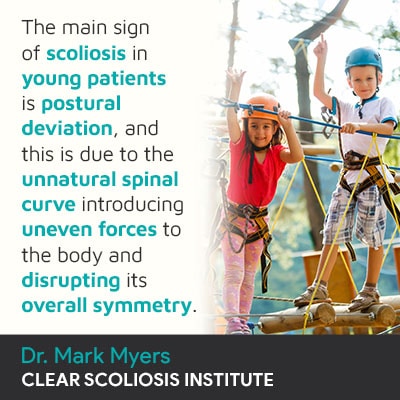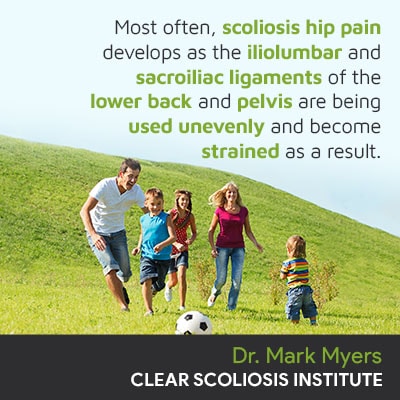
With close to 7 million people currently living with scoliosis in the United States alone, we are talking about a highly-prevalent spinal condition. When it comes to scoliosis hip pain, is due to an unnatural spinal curve introducing uneven forces to the body, and proactive treatment that addresses its underlying cause has the potential to relieve it.
As a complex spinal condition, scoliosis can cause a wide range of symptoms, including postural changes and pain. The most common visual symptom of scoliosis involves changes to posture, such as uneven hips; the best way to relieve condition-related hip pain is to treat the condition proactively.
Let’s first talk generally about scoliosis, and the parameters that have to be met to reach a scoliosis diagnosis, before addressing the specifics of scoliosis hip pain.
For someone recently diagnosed with scoliosis, this means they have developed an unnatural sideways spinal curve, with rotation, and a minimum Cobb angle of 10 degrees.
Cobb angle is a measurement taken during X-ray by drawing lines from the tops and bottoms of the most-tilted vertebrae (bones of the spine) at the apex of the curve.
The resulting angle is measured in degrees, tells me how far out of alignment a spine is and, also classifies conditions based on severity:
As you can see from the wide range in measurements, scoliosis is a highly-variable condition, meaning no two cases are the same, and each patient’s condition will produce its own unique set of symptoms based on severity, and other important classification points: patient age, curvature location, and cause (if known).
Another important condition characteristic to understand is the progressive nature of scoliosis; it’s in the very nature of the condition to worsen over time, particularly if left untreated, or not treated proactively.
So what are some common scoliosis symptoms, and how do they involve the hips?
As mentioned, each case of scoliosis is as unique as the patient themselves, and when it comes to common symptoms, patient age is a significant factor to address.
The most prevalent form of scoliosis is adolescent idiopathic scoliosis (AIS), diagnosed between the ages of 10 and 18, and while scoliosis is more common in children and adolescents, it also affects adults.
As growth is the condition’s main trigger for progression, adolescents and children are at risk for rapid-phase progression, due to the stage of growth and development they are in, or entering into.

In fact, uneven hips are one of the condition’s telltale early signs, and other common postural symptoms can include:
As a result, clothing can become ill-fitting and changes to gait, balance, and coordination are also common scoliosis symptoms in both adolescent and adult patients.
In general, other than some related muscle pain, scoliosis isn’t commonly described as painful by children and adolescents, and this is because scoliosis doesn’t become compressive until adulthood.
Once skeletal maturity has been reached, the spine and its surrounding muscles, ligaments, and nerves are exposed to compression, which is the main source of condition-related pain.
In young patients, the lengthening motion of a growing spine counteracts the compressive force of a scoliotic curve, and this is one of the reasons early detection can be a challenge with adolescents: they don’t commonly find the condition painful, and particularly in mild forms, functional deficits are rare, and postural changes can be subtle.
So what causes uneven hips and related scoliosis hip pain?
What Causes Scoliosis Hip Pain?
While uneven hips can be a visual symptom in both adolescent and adult scoliosis, as the condition becomes compressive in adulthood, related hip pain is more likely to be an issue for adults.
As a 3-dimensional condition, a scoliotic spine doesn’t just bend unnaturally to the side, it also twists from back to front, front to back (rotational component), and as this disrupts the body’s overall symmetry, posture is impacted.
As scoliosis progresses, the unnatural spinal curve is increasing in size, and related postural deviation tends to increase alongside condition severity.
For adults, scoliosis hip pain can range from mild to severe and tends to be most intense when having to stand for long periods, or during times of physical exertion.
Hip pain can develop as a scoliotic curve causes the pelvis to tilt unnaturally, resulting in one hip having to support more weight than the other, which means tendons and supportive muscles are being used unevenly and can become sore and painful.
Hip pain is also related to ligaments becoming overstretched as they struggle to support an unnatural spinal curve.

The iliolumbar and sacroiliac ligaments are durable bands of connective tissue that provide the lumbar spine (lower back) with support and stabilization, where it meets the sacrum (triangular-shaped bone between the hip bones).
Hip pain can also be the result of pelvic dysfunction as scoliosis can shift a body’s center of gravity and change how a person walks.
Disruptions to natural gait and movement patterns also cause uneven wear and tear on the body parts/systems facilitating movement: the spine, pelvis, and hips.
Fascia also plays a role in scoliosis hip pain as all forms of movement engage muscles and fascia. Fascia is a casing of connective tissue that protects organs, bones, nerve fibers, blood vessels, and muscles.
The fascia holds things in place and provides internal structure, and as fascial restriction becomes an issue, the affected area is becoming tighter and more rigid; this is due to a combination of adverse tension and unnatural changes in movement patterns and body positioning.
So scoliosis can cause hip pain by affecting the position of the spine and pelvis, overall posture, where the lumbar spine meets the sacral spine, and its surrounding muscles, ligaments, and fascia.
While scoliosis is known to cause uneven hips and related pain, adults are more likely to experience condition-related hip pain because they are more vulnerable to the compressive force of a scoliotic curve.
Now that we have explored the nature of scoliosis hip pain, including its causes, let’s address how to relieve it.
How to Relieve Scoliosis Hip Pain
As a CLEAR-certified scoliosis chiropractor, I believe in proactive treatment started as close to the time of diagnosis as possible; early detection, when followed by proactive treatment, can increase the chances of treatment success.
When it comes to addressing condition-related pain, the key is determining its underlying cause and designing a proactive and customized treatment plan around it as this is the difference between treating a condition’s symptoms, or the condition itself.
So when it comes to relieving scoliosis hip pain, I work towards this by addressing its underlying cause: the unnatural spinal curve.
As scoliosis is a structural condition, effective treatment has to, first and foremost, impact the condition on a structural level in the form of a curvature reduction; this can be achieved through condition-specific chiropractic care.
I also help patients increase their core strength by using physical therapy and custom-prescribed scoliosis-specific exercises (SSEs) as this can help keep the spine and its surrounding muscles as strong, loose, and flexible as possible.
Stronger muscles means more support/stabilization for the spine, and as muscle strength increases, uneven muscle use is targeted next: addressing one of the underlying causes of scoliosis hip pain.
While there are no treatment guarantees, through a conservative chiropractic-centered treatment approach that integrates chiropractic adjustments, in-office therapy, custom-prescribed SSEs, and when needed, corrective bracing, symptoms such as hip pain are reduced/eliminated as the underlying structural cause is being addressed and treated proactively.
In order for the spine to function optimally, it needs to maintain its natural and healthy curves and alignment.
When a spinal condition that involves a loss of its healthy curves, such as scoliosis, develops, the biomechanics of the entire spine is disrupted, and this can affect the body in a number of ways.
As scoliosis is an unnatural sideways spinal curve with rotation, it introduces a lot of uneven forces to the body, and these uneven forces disrupt the body’s overall symmetry, in the form of postural deviation.
Among the condition’s earliest visual signs are uneven shoulders and hips, and for adults, pain is the main symptom of scoliosis.
In addition to general back pain and radicular pain commonly felt in the legs and feet, hip pain can be caused by the unnatural pelvic tilt that can develop as a scoliotic curve disrupts the position of the pelvis and causes one hip to sit higher than the other and support more weight.
Unnatural movement patterns, strained fascia, muscles, and ligaments that are being used unevenly, and experiencing uneven wear and tear, as a result, are all causes of scoliosis hip pain.
When it comes to relieving scoliosis hip pain, I adhere to the CLEAR Scoliosis Institute treatment protocols that value proactive treatment and addressing a symptom’s underlying cause: impacting the condition on a structural level by working towards a curvature reduction.
As condition-specific chiropractic care works towards adjusting the most-tilted vertebrae back into a healthier alignment with the rest of the spine, the uneven forces causing postural deviation and impacting movement/posture are also being addressed.
The time to start scoliosis treatment is always now, regardless of age, and the most effective means of relieving scoliosis hip pain is by customizing a proactive treatment plan that impacts the condition on multiple levels.

CLEAR provides a unique and innovative way of understanding scoliosis. Sign up to receive facts and information you won’t find anywhere else.

I had hip replacement in November 2022. I have severe scoliosis & since the hip operation I am tilted & can’t straighten up when I walk. I have a lot of pelvic pain.I have been doing physical therapy but doesn’t seem to be working.
Hello, Peggy,
Thank you for reaching out. Hip replacement can definitely aggravate symptoms of severe scoliosis. However, even with the hip replacement, it does not disqualify you from receiving scoliosis care. I suggest contacting the nearest CLEAR Scoliosis Institute certified clinic to determine if you would be a candidate for care and what they would recommend for your specific needs. They would be able to look over your imaging, do an evaluation, and determine best steps to help you with the pain and gait issues. To find the nearest clinic, please visit our website under Find a Doctor. Please let us know if we can be of further assistance. Best of luck.